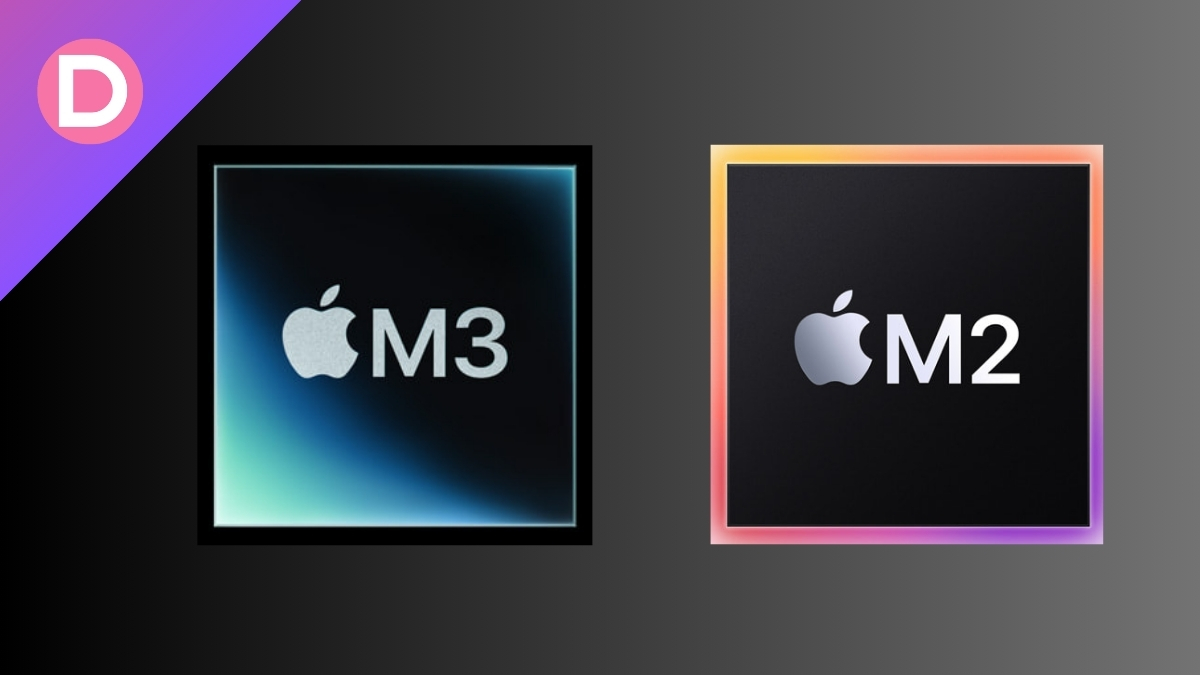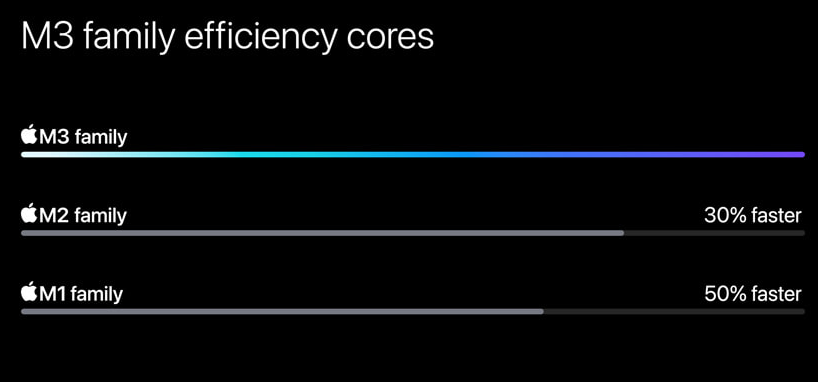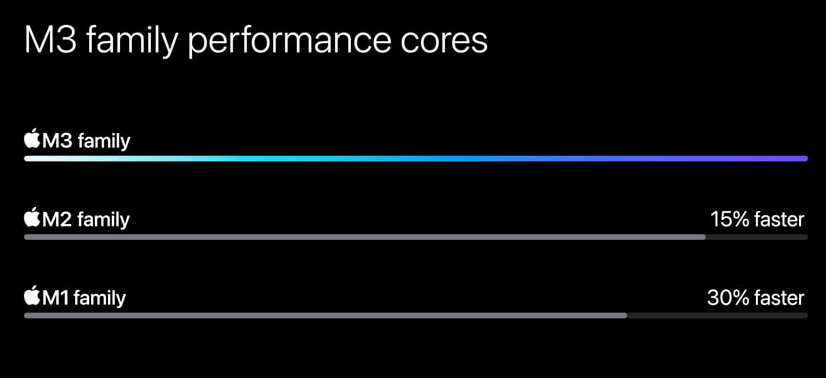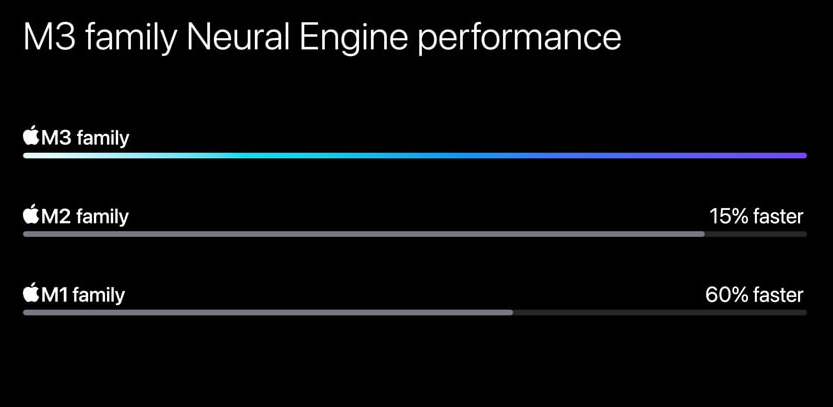Apple’s “Scary Fast” event just wrapped up, wherein Apple revealed the next generation of Apple Silicon and new Macs. Apple announced three new chipsets in the M3 family, including M3, M3 Pro, and M3 Max. These chipsets power the new iMac 24” and the new MacBook Pro 14” and 16”.
During the event, Apple constantly compared the new chipsets to the M1 family instead of the M2. Surely, the M3 family is a great upgrade over the M1, but comparing it to the M2 family makes more sense. As always, Apple used some vague graphs when comparing the M3 family.
Since there wasn’t much revealed at the event, there is a question about the improvements the M3 family brings over the M2 family. Is this a significant upgrade? Should you consider upgrading from an M2 Mac to an M3? Let us find out in this article.
CPU Performance
The configurations and core counts of Apple’s M3 processors are highly diverse—the processor capabilities of the M3 family range from 8 to 16 cores. On the M2, the range starts from 8 to 12 for the M2 Max. Moreover, the M3 Pro now has the same number of cores as last year’s M2 Max.
Moving on, Apple claims that the new M3 chipset’s high-performance core is 15% faster than its M2 counterpart. The efficiency core of the M3 is additionally 30% faster than that of the M2. These advancements hold great potential for applications that demand both power and efficiency.
Nevertheless, the ultimate efficacy is decidedly in part by the architecture of the CPU cluster. In contrast to the M2 Pro, which incorporates eight high-performance cores and four efficiency cores (8P + 4E), the architectural design of the M3 Pro is different.
Conversely, the M3 Pro uses a more moderate stance through the integration of six efficiency cores (6P + 6E) with a total of six high-performance cores.
Since the number of performance cores has reduced to just six, with the rest being efficiency cores, it is unclear whether or not it brings any significant gains over its predecessor, the M2 Pro. Although Apple said the M3 Pro is 20% faster than the M1 Pro, they didn’t state any improvements over the M2 Pro.
As for the 16-core (12P + 4E) M3 Max, Apple’s benchmarks indicate that the M3 Max’s CPU is approximately 50% faster than the M2 Max. In the case of the 8-core CPU, it is up to 20% faster than its M2 counterpart.
3 nm and Transistors
A modern computer chip’s CPU is probably the most essential part, and the Apple M3 features one of the most potent available. Thanks to TSMC’s cutting-edge 3 nm manufacturing, the CPU in the M3 has seen many respectable improvements.
The Apple M3 is notable for the number of transistors it contains, thanks to the 3 nm fabrication process. The M3 family starts at 25 billion transistors, climbs to 37 billion in the M3 Pro, and then blows everyone away with 92 billion in the M3 Max.
GPU Performance
With regard to GPU performance, the Apple M3 achieves noteworthy progress in providing an improved GPU experience. The GPU architecture and features of the M3 have undergone a significant enhancement, at least as per what Apple has to say.
The Apple M3 uses a next-generation GPU architecture, which stands out as a particularly noteworthy advancement. This enhancement grants the M3 the capability to operate many advanced features that ensure an outstanding GPU experience.
The Apple M3 provides a diverse selection of GPU cores. The base M3 has 10 GPU cores. The M3 Pro offers 14 and 18 GPU cores, whereas the M3 Max surpasses all others with 40 GPU cores.
Apple has not held back on the M3’s hardware acceleration capabilities this time. Hardware-accelerated Ray Tracing infuses gaming with a fresh dimension, providing content creators and gamers with mesmerizing lighting effects and a robust reflection system.
The GPU of the M3 also facilitates the processing of intricate geometric designs via HW-accelerated Mesh Shading. This notably improves the rendering of complex visual sequences in games and applications heavily relying on graphics.
One of the most notable enhancements to the GPU capabilities of the M3 is Dynamic Caching, which, from what we understand, improves efficiency. This new technology enables the chipset to allocate hardware system-level memory dynamically and in real-time.
As a result, the M3 is capable of allocating the exact quantity of memory required, which enhances both performance and efficiency. This technology guarantees the GPU functions at its highest potential, providing users with a smooth and fast experience.
Apple’s assertions regarding the M3’s GPU’s performance are similarly noteworthy. As per Apple’s benchmarks, the M3’s 10-core GPU exhibits an approximate 20% increase in speed compared to the M2’s GPU.
Also, the 18-core GPU in the M3 Pro is approximately 10% faster than that of the GPU in the M2 Pro. Finally, the 40-core GPU of the M3 Max is also 20% faster than the GPU of the M2 Max.
Although Apple claims to use a next-generation GPU architecture, the performance gains don’t seem out of this world. Don’t get me wrong; these are respectable gains for just one generation.
The M3 is designed to deliver graphics performance thanks to its next-generation architecture, a notable 10% to 20% enhancement over the M2 family, and support for hardware-accelerated features such as Mesh rendering and Ray Tracing. Plus, Dynamic Caching significantly improves memory allocation and overall system performance.
Neural and Media Engine
The Apple M3’s Neural Engine, a core component of ML and AI, has seen significant improvement. The Neural Engine in the M3 is supposedly 15% more powerful than the one in the M2. Also, the M3’s neural engine is now 60% more powerful than the M1’s.
The M3’s Neural Engine enhances the user experience in AI-reliant workloads like augmented reality, speech recognition, and image processing through, among other things, increased fluidity and responsiveness.
While the M3’s Neural Engine is an upgrade over the M2, it is hardly a major step forward. A major improvement to the Apple M3 is that its Media Engine can now decode AV1, unlike the M2. AV1 is a more compact video codec that nonetheless maintains great visual quality.
AV1 support means that you will not have any trouble watching AV1-encoded video on major streaming sites like YouTube and Netflix. The Media Engine is compatible with numerous video codecs, such as H.264, HEVC, ProRes, and ProRes RAW, just like the M2.
Memory and Bandwidth
The memory specifications of a chipset are critical in establishing its overall capabilities and performance. Compared to its predecessor, the M2, the Apple M3 brings some improvements and unexpected downgrades.
Before proceeding, it is essential to examine memory bandwidth, which is a fundamental component of the memory performance of a chip. With a direct bearing on its overall speed and efficiency, the memory bandwidth of a chipset essentially determines how fast it can read from and write to its memory.
The base variant of the Apple M3 retains the identical memory bandwidth of the M2, which is 100 Gbps. However, as we ascend the M3 lineup, we observe some new changes. The M3 Pro has a memory bandwidth of 150 Gbps, a marginal reduction from the M2 Pro’s 200 Gbps. Keeping this in mind, it is possible that Apple modified the M3 Pro’s memory bus interface from 256 bits to 192 bits.
The memory bandwidth for the top-tier M3 Max also changes upon the configuration of the CPU. Selecting the M3 Max with a 14-core processor will give you access to 300 Gbps of memory. This is clearly a downgrade in performance compared to the M2 Max, which had a speed of 400 Gbps across all configurations.
Only the M3 Max with a 16-core processor offers the identical 400 Gbps memory bandwidth. It is important to acknowledge that this adjustment in memory bandwidth may be interpreted as an effort by Apple to promote the highest-end model. This tactic may not appeal to consumers in search of more affordable alternatives.
Apple’s unified memory strategy for the M3 also has some interesting things. Like its predecessor, the M2, the M3 uses LPDDR5 unified memory. Nevertheless, the M3 does feature a significant improvement in the form of 128GB unified memory. This surpasses the prior peak of 96GB that was available with the M2 Max.
An increased memory bandwidth facilitates faster data access by the processor, leading to enhanced performance in terms of speed and responsiveness. On the contrary, reduced memory bandwidth may result in performance bottlenecks, especially for certain tasks and applications that require a significant amount of memory.
Particularly when the chip is under intense memory load, the variations in memory bandwidth between M3 variants may indicate performance disparities, for users who choose the 14-core CPU-equipped M3 Max may face a marginally diminished memory performance compared to the M2 Max. The memory capability of the M3 Max with a 16-core CPU is, however, similar to that of the M2 Max.
Conclusion
The Apple M3 chip brings an overall good incremental year-on-year upgrade over its predecessor, the M2 chip. While the performance and efficiency gains are not as significant when compared to the gains from M1 to M2, these are commendable performance gains for one year.
Not to mention, the M3 chip is based on TSMC’s latest 3 nm fabrication process, which is more power efficient and allows room for more transistors. Plus, we can’t forget Dynamic Caching and the support for hardware-accelerated ray tracing.
The M3, M3 Pro, and M3 Max are some of the best desktop chips on the market. However, if you already have an M2 family Mac, you probably don’t need an upgrade since the performance gains are not worth an upgrade. Nevertheless, M1 users can look forward to upgrading, especially those using an M1 MacBook Air or the MacBook Pro 13”.






